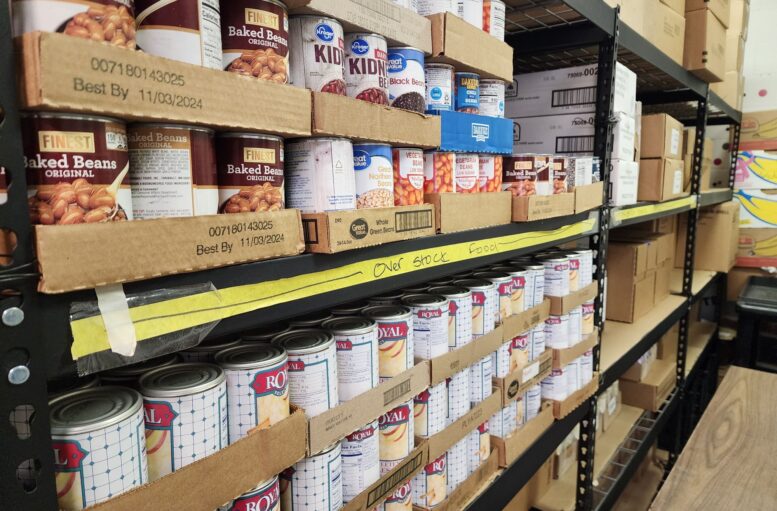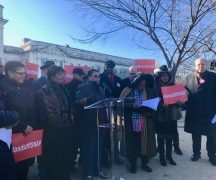The executive director of the Ohio Association of Foodbanks is trying to get the word out: If the budget passed by the U.S. House of Representatives becomes reality, it could trash the state budget and make many, many Ohioans go hungry.
The matter goes next to the U.S. Senate. But the members of the Ohio delegation aren’t talking.
The House-passed Republican reconciliation budget — President Donald Trump’s “One Big Beautiful Bill” — would hand out $4.6 trillion in tax cuts over 10 years. In an analysis, Trump’s alma mater, the University of Pennsylvania’s Wharton School, estimated that 70% of the benefit would go to the “top 10% of the income distribution.”
Meanwhile, the “Department of Government Efficiency” — led by the world’s richest man— has been looking to cut services for average Americans. One place the Republican House budget seeks to achieve some of those cuts is to the Supplemental Nutrition Assistance Program, or SNAP.
Also known as food stamps, the program provides debit cards for food. To qualify, Ohio recipients generally have to have net income at or below federal poverty guidelines — $32,150 a year for a family of four.
Benefits awarded under the program are pretty modest, $6.28 per person, per day on average last year. And, as a reflection of the high level of poverty in the state, one in nine Ohioans — or 1.4 million — received them last year.
Whether Ohio’s poorest will get those food benefits in future years is an open question in light of the One Big Beautiful Bill.
“The House-passed Republican reconciliation plan would cut nearly $300 billion from the Supplemental Nutrition Assistance Program (SNAP) through 2034, based on Congressional Budget Office (CBO) estimates — by far the largest cut to SNAP in history,” the Center on Budget and Policy Priorities wrote last week. “As a result of these cuts and other policies in the legislation — which are being used to pay partly for trillions in tax cuts skewed to the wealthy — millions of people would lose some or all of the food assistance they need to afford groceries, when many low-income households are struggling to afford the high cost of food and other basic needs.”
The bill would force states to take up the slack by forcing them to pay based on error rates. In other words, they’d have to pay at least 5% more and then go up a sliding scale based on how often they were found to pay recipients too little or too much in benefits. It also would greatly increase error rates by eliminating the current tolerance for small errors — those up to $57.
This all might sound technical, but the consequences for Ohio would be huge.
If it had an error rate of 6% or less (which it doesn’t, even under the current, more-tolerant system), the state would have to pay $158 million more a year into the program, according to the Center for Budget and Policy Priorities. At the top end, with an error rate of 25% or more, Ohio would have to pay $790 million more a year.
Under the Republican bill, error rates would surely go sharply up. But even under Ohio’s most recent rate, the state would take a massive hit. At 15% errors, the state would have to come up with $473 million a year.
“That’s almost $500 million in new state revenue that they would have to come up with just to maintain current levels of benefits,” said Joree Novotny, executive director of the Ohio Association of Foodbanks. “That’s roughly equivalent to the entire state investment in the Ohio Department of Job and Family Services” which administers SNAP in addition to many other programs.
Novotny is worried that Ohio’s food banks would be stretched even worse under such cuts than they were after expanded SNAP benefits during the covid pandemic expired.
“We know that we can’t ever make up for the value that SNAP benefits provide to low-income working families, seniors and people with disabilities,” she said. “We’re not designed to be a first-line grocery store. SNAP invests directly in local economies. Benefits are spent at local grocers. The removal of this investment in that supply chain… I’m not only concerned about access to affordable food for people with lower resources, but also sustainability and resilience in the food-supply sector as a whole.”
Novotny said two bad-but-likely results would be bigger food deserts and less access to healthy nutrition. Those outcomes would be particularly devastating to low-income families who have seen food prices grow 27% between mid-2020 and the beginning of this year.
Asked whether Gov. Mike DeWine opposed the SNAP cuts in the Republican bill, his press secretary, Dan Tierney, was noncommittal.
“As we have seen, these proposals can change dramatically as the process proceeds,” Tierney said in an email. “We have generally reserved comments until after final proposals have been adopted.”
The offices of Sens. Jon Husted and Bernie Moreno were asked if they would support the cuts when the House bill came before them. Neither replied.
For her part, Novotny said she has an even deeper concern than overwhelmed food banks and growing food deserts.
Asked what would happen if states can’t or won’t find the money the House budget is demanding for SNAP, she said, “We can’t get a good answer to that.”
“Fundamentally, will SNAP remain an entitlement? Will states have to administer the program at all?” she asked. “Fundamentally, it’s hard to understand how it would be required of a state to participate in the program if there’s such a significant cost burden.”
The question, at bottom, is whether the already huge number of poor Ohioans will swell and whether they’ll be pushed even deeper into poverty and food insecurity.
“I’m most concerned about what it would mean for the structure of the federal nutrition safety net,” Novotny said. “SNAP is and always has been an entitlement program. If you’re a worker who, through no fault of your own, loses your job and while you’re seeking work you need help affording groceries so that you can stay in your house… SNAP is there. Or if you’re a person who receives a really serious cancer diagnosis and you have to use some (Family and Medical Leave Act benefits) to come and get treatment, SNAP is there. If you’re a low-wage working family, or if you’re a senior on a fixed income, SNAP is there and the benefit has always been fully federally funded.”





